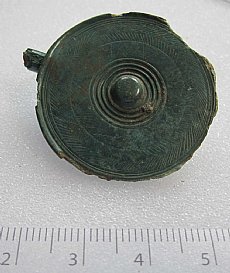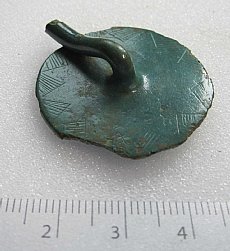Bronze Age Metalworking
Posted by Susan Kruse - 11:33 on 28 June 2018
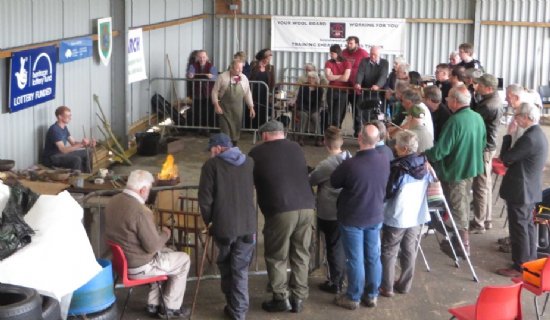 In our June Experimental Archaeology workshop Neil Burridge, a metalsmith from Cornwall, provided a fascinating insight into Bronze working techniques and the roll of a smith through the ages. Neil was the inspiration for the Experimental Archaeology project, when in 2013 he recreated objects made at North Kessock, identified by broken moulds in pits. That day was full of insight and drama – as indeed was this return visit. Although health and safety considerations meant this was a demonstration, there was plenty to see and learn.
In our June Experimental Archaeology workshop Neil Burridge, a metalsmith from Cornwall, provided a fascinating insight into Bronze working techniques and the roll of a smith through the ages. Neil was the inspiration for the Experimental Archaeology project, when in 2013 he recreated objects made at North Kessock, identified by broken moulds in pits. That day was full of insight and drama – as indeed was this return visit. Although health and safety considerations meant this was a demonstration, there was plenty to see and learn.
Whereas the last time Neil came we used the North Kessock finds as the starting point, this time we focussed on finds from Dores near Inverness. There a hoard of Bronze Age metalwork was recently discovered at Baile-a-chladaich, consisting of complete objects, fragments and casting waste. Nearby at Dirr Wood a Bronze Age sunflower pin was then found in foundations of a roundhouse. These objects are now in Inverness Museum, though not currently on display.
We asked Neil to try and cast a replica of the bronze sunflower pin recently found near Dores. While there have been a number of people making weapons and tools, as far as we knew little attention has been paid to these pins. The example from Dirr Wood is now a dull green patina, with most of its pin shaft broken off (see above). However, examples from elsewhere, including a recent find from Carnoustie, provide some idea of its long length. There are other pins from the Highlands too, including from a hoard near Dingwall and one from Loggie near Ullapool, each showing different types of decoration. The Dores pin has line decoration on front and back.
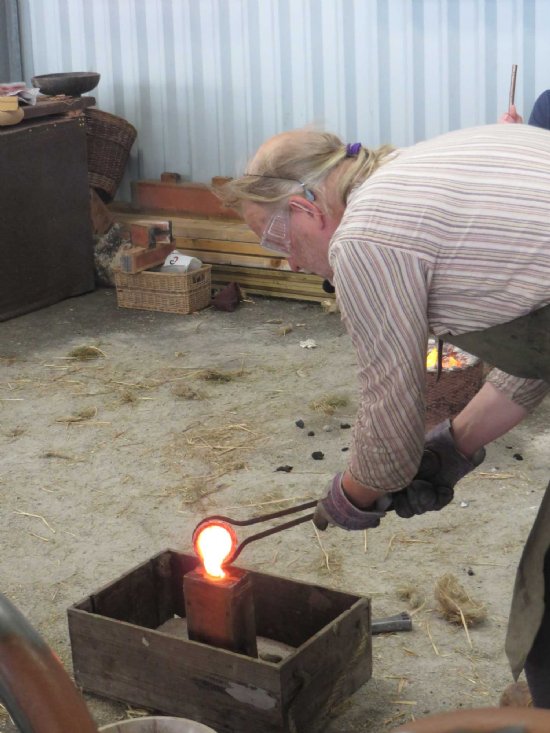 Neil explained how the pin would have been made, probably in two parts using clay moulds. For this demonstration he used sand, but otherwise traditional techniques – although he does use a modern temperature gauge, whereas the ancient craftsmen would have done it all by eye. He also notes how much he learned by making the object, again coming away with profound resp
Neil explained how the pin would have been made, probably in two parts using clay moulds. For this demonstration he used sand, but otherwise traditional techniques – although he does use a modern temperature gauge, whereas the ancient craftsmen would have done it all by eye. He also notes how much he learned by making the object, again coming away with profound resp
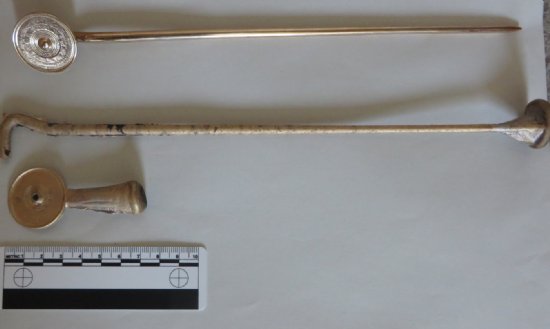
with finished example above
Neil explained how the pin would have been made, probably in two parts using clay moulds. For this demonstration he used sand, but otherwise traditional techniques – although he does use a modern temperature gauge, whereas the ancient craftsmen would have done it all by eye. He also notes how much he learned by making the object, again coming away with profound respect for these smiths 3,000 years ago. The rim is slightly raised which created some difficulties in construction, and it would have been much easier to just create a flat disc. The resulting casting would have had decoration applied, perhaps with a simple lathe, and the shaft then joined to the pinhead. Neil brought one he had made and decorated earlier. It is stunning, and clearly must have been a mark of status. Neil notes that some of these pins are found with swords and speculates that they may have been associated.
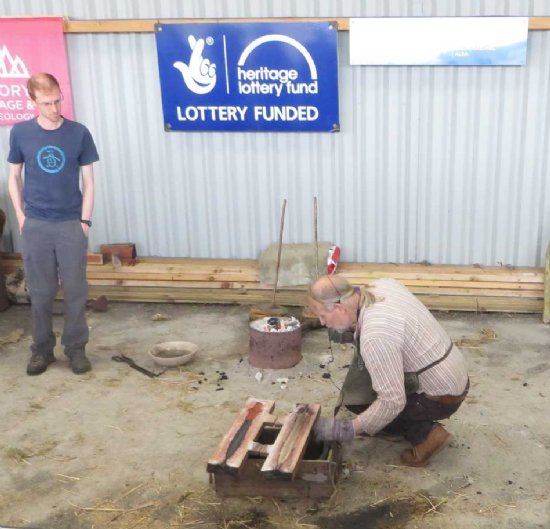 After casting a pin, Neil then made a tool – a socketed gouge. An example was found in the Baile-a-chladaich hoard, as well as in the Wester Ord hoard near Invergordon. But as evaluations showed, the main attraction for many of the audience was the casting of a bronze sword. This required a fair amount of preparation, and while working on getting the metal ready, Neil explained about the raw materials used to make Bronze (tin and copper), passing examples around, the spread of metalworking skills, the place of swords in Bronze Age society, and much more.
After casting a pin, Neil then made a tool – a socketed gouge. An example was found in the Baile-a-chladaich hoard, as well as in the Wester Ord hoard near Invergordon. But as evaluations showed, the main attraction for many of the audience was the casting of a bronze sword. This required a fair amount of preparation, and while working on getting the metal ready, Neil explained about the raw materials used to make Bronze (tin and copper), passing examples around, the spread of metalworking skills, the place of swords in Bronze Age society, and much more.
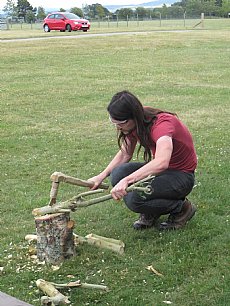 Bronze objects were expensive and clearly related to status, but would they have also had a practical use? Neil believes the weapons and tools clearly had practical uses. He noted that axes often show hardening and sharpening on their edge (as is the case from the Dores axeheads – and to demonstrate he took an early Bronze Age flat axe replica, bound it to a wooden haft, and showed how it could cut wood. He notes other studies show just how deadly spears and swords would have been.
Bronze objects were expensive and clearly related to status, but would they have also had a practical use? Neil believes the weapons and tools clearly had practical uses. He noted that axes often show hardening and sharpening on their edge (as is the case from the Dores axeheads – and to demonstrate he took an early Bronze Age flat axe replica, bound it to a wooden haft, and showed how it could cut wood. He notes other studies show just how deadly spears and swords would have been.
Altogether it was a fascinating day – and again shows the value of combining the evidence from archaeological objects with the practical skills of a craftsman.
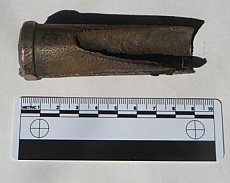 For the loans box, Neil has provided the replica of the Dirr Hill pin, two gouges and three axeheads – which together with the sickle, spearhead and swords created during the North Kessock project and kindly donated by the North Kessock & District Local History Society, makes a nice little hoard in itself, and will provide a valuable insight into Bronze Age metalworking.
For the loans box, Neil has provided the replica of the Dirr Hill pin, two gouges and three axeheads – which together with the sickle, spearhead and swords created during the North Kessock project and kindly donated by the North Kessock & District Local History Society, makes a nice little hoard in itself, and will provide a valuable insight into Bronze Age metalworking.
Other Resources
Books and Articles
The results of the North Kessock project have been published in 2017 in Feats of Clay. Bronze Age metalworking around the Moray Firth, by Graham Clark, Trevor Cowie and Susan Kruse, available from the North Kessock and District Local History Society for £7.50, excluding P&P. This includes an illustrated catalogue of known metalwork from the southern Highlands (bounded Auldearn to Glenurquhart, Dornoch Firth to Aviemore). Bronze Age metalworking is also featured in Trevor Cowie’s 1988 publication Magic Metal: Early Metalworkers in the North-East, Aberdeen.
Brysbaert, A., 1998. 'A Late Bronze Age Sickle from Shinewater Park: The Treatment of a Waterlogged Composite,' Journal of Conservation and Museum Studies, 4, pp.1–5. Survival of a wooden handle for a Bronze Age sickle. http://doi.org/10.5334/jcms.4981
Objects on display in Highland Museums
A number of museums have Bronze Age metalwork on display, particularly Inverness Museum and Art Gallery. The Poolewe hoard will be coming to the new museum in Gairloch, joining other single finds on display.
Images online
A number of images of Bronze Age metalwork from the Highlands is available on the internet, particularly on the SCRAN website. (Note that if you have a Highland Library card, you can get free access to the full record on SCRAN).
- Late Bronze Age hoard from near Dingwall, with a sunflower pin, axeheads and neckring.
Details on SCRAN and ARCH websites - Dail na Caraidh, near Fort William hoard of early Bronze Age axes and daggers on display at Inverness Museum and Art Gallery. Details on SCRAN
- Bronze Age sword from Inverbroom. Details on SCRAN
- Anvil with scrap hammerhead and spearhead from Auldearn on display in Inverness Museum and Art Gallery. Details on SCRAN
- Stittenham Late Bronze Age axehead mould. Details on SCRAN and ARCH website
- Knockgrainish Early Bronze Age axeheads, on display at Inverness Museum and Art Gallery. Details on SCRAN
- Early Bronze Age axehead from Auldearn. Details on ARCH website
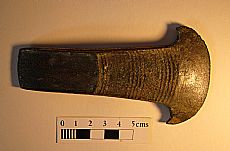 Early Bronze axehead from Culbin near Evanton, now on display in Dingwall Museum. Details on ARCH website
Early Bronze axehead from Culbin near Evanton, now on display in Dingwall Museum. Details on ARCH website- Decorated axehead from Nairn. Details on SCRAN
- Poolewe late Bronze Age hoard with axeheads, rings and cup-shaped ornament. Details on SCRAN
- Heights of Brae gold hoard (on display at the NMS in Edinburgh, with replicas in Inverness Museum and Art Gallery). Details on SCRAN
Videos
There are a number of videos available on the internet including those showing Neil working:
Ewart Park Bronze Age Sword
13:40
Liquid fire to metal
3:13
as well as James Dilley, who did our flint knapping workshop:
Bronze Age Casting - Axe heads
3:28
Websites
Neil Burridge’s website: Bronze Age Craft
The Experimental Archaeology: Learning about technologies in the past project has been funded by Historic Environment Scotland and the Heritage Lottery Fund.
Add your comment below
- Recent Blog Articles
- Learning Resources
- Crafting Day October 2018
- Medieval Coinage Workshop
- Viking Ring-Money workshop
- Thomas Telford Workshop
- Monthly Blog Archive
- June 2018
- May 2018
- April 2018
- March 2018
- February 2018
- January 2018
- December 2017
- November 2017

